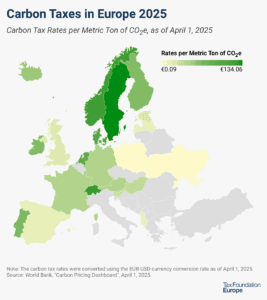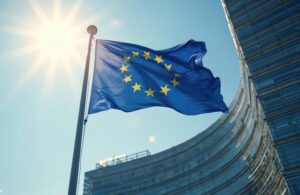
Post-Versailles Declaration: Tax Policy in the Future of European Energy Security
6 min readBy:In 2020, the EU agreed to the European Green Deal, which sets out to make the union climate neutral by 2050, and in 2021, the Fit for 55 package, which is intended to cut emissions by at least 55 percent by 2030. Both legislative packages outline various ways for the EU to reduce reliance on fossil fuels and transition to cleaner energies.
Now, Russia’s war against Ukraine has made energy (and related tax policies) an even more urgent focus for the EU.
On 11 March 2022, French President Emmanuel Macron hosted the EU’s 27 heads of state and government at the Palace at Versailles to discuss European security. EU leaders described Russia’s invasion of Ukraine as a “tectonic shift in European history.” On the heels of Germany’s announcement to increase domestic defense spending by 100 billion euros in February, the unified signing of the “Versailles Declaration” is a historic break from the past.
The declaration announces the EU’s intention not only to rearm but also to become autonomous in food, energy, and military hardware. The question for the EU is how quickly can this be done under threat and what role does taxA tax is a mandatory payment or charge collected by local, state, and national governments from individuals or businesses to cover the costs of general government services, goods, and activities. policy play particularly on the energy side?
Against this background, the EU faces the challenge of needing to implement policies that reduce reliance on Russian energy in the short term, help achieve the EU’s broader climate goals in the long term, and protect the economy from energy price inflation throughout. The policy proposals currently being explored include price controls, windfall taxes, and redirection of funds from the EU’s Emissions Trading System (ETS). While a reliance on ETS funds to support vulnerable businesses and households makes sense, the other approaches have significant flaws that would lead to negative economic consequences.
In October 2021, the European Commission released a communication outlining a toolbox of measures Member States could use to respond to the spike in wholesale energy prices due to the COVID-19 pandemic. The toolbox included measures such as regulating prices for vulnerable consumers, temporary taxes on windfall profits, redirecting revenues from the ETS to ease pressure on household consumers, and providing support to companies affected by high energy prices.
Since October, the Commission estimates that special measures introduced by 25 Member States have affected 71 million household customers and several million businesses.
However, Russia’s energy and security threats are forcing the EU to amplify efforts to address skyrocketing fuel and electricity costs. EU leaders agree that the rapid transition away from reliance on Russian energy sources and fossil fuels in general will benefit the EU’s climate objectives, but there is less agreement about how to finance such an expensive energy transition.
Since the invasion of Ukraine began on 24 February, the EU has imposed harsh sanctions on the Russian economy and scrambled to break its reliance on Russian energy imports. The latter is proving difficult to do quickly. Due to supply uncertainty, European energy costs are skyrocketing even higher than during the COVID-19 pandemic for both consumers and businesses.
The Commission announced a new plan on 8 March called REPowerEU to make the EU independent from Russian fossil fuels by 2027 and reduce EU demand for Russian gas by two-thirds before the end of 2022. It plans to do so by diversifying gas supplies, speeding up the rollout of renewable gases, and replacing gas in heating and power generation.
Currently, the EU imports 90 percent of its gas consumption, with Russia providing roughly 45 percent of those imports. Russia also accounts for roughly 25 percent of oil imports and 45 percent of coal imports. The Versailles Declaration tasks the Commission to produce proposals on how to achieve REPowerEU’s reduction targets by mid-May.
On the demand side, REPowerEU builds off the 2021 toolbox and outlines short-term price regulation and windfall tax measures Member States can use. The Commission will also consult with Member States on a new plan to provide support to companies affected by the crisis from ETS revenue. The ETS raises funds by taxing the annual pollution a company releases into the air through a cap-and-trade system.
While the 2021 toolbox and new REPowerEU are well intended as short-term measures, these demand-side policies have significant flaws with negative economic consequences.
The Commission’s guidance allows for Member States to regulate energy prices in exceptional circumstances. However, according to Article 5 of the EU’s Electricity Directive, “it is important that the price regulation does not undermine wider objectives of EU energy policy and the Electricity Directive. These objectives include competitive markets, consumer empowerment, an increase in renewables, a flexible electricity system and greater energy efficiency.”
In the current situation, price controls would not fulfill these requirements. For one, capping the price of electricity would not increase access to renewables because companies would have less capital to invest in cleaner technology.
Furthermore, simply regulating the price of electricity does not ensure greater energy efficiency. Rather, by suppressing the pricing mechanism of the market, the incentive to limit energy use is distorted.
The Commission’s guidance also allows for Member States to implement windfall taxes on energy company profits that are deemed to be “excessive.” Governments could then redistribute these revenues to electricity consumers directly to help offset high prices. The guidance requires these policies to be tied to a specific crisis and not affect wholesale electricity prices
However, rising prices are currently being driven more by supply disruptions than company decisions. Because of this, implementing a unique, temporary tax on businesses makes little sense.
Secondly, to successfully transition energy sources, companies need tax certainty and capital to invest. Temporary taxes that have varying end dates depending on a military conflict are counterproductive to longer-term goals of the energy transition.
Finally, with prices continuing to climb, it is unclear how much of an impact payments to consumers will have in helping to make energy affordable.
At the end of the day, consumers might still be unable to afford their bills and companies would have less money to invest in the green transition. In short, a windfall tax would not be a helpful proposal and impacts of similar windfall tax proposals have historically been negative.
The Commission’s guidance says that Member States may use ETS revenues to provide emergency income support for energy-poor consumers through vouchers or partial bill payments. From 2018-2020, total ETS revenues amounted to €14 billion-16 billion annually. As energy prices continue to rise, and therefore likely ETS revenues as well, the scope and stability of this revenue stream could be a better alternative for governments than temporary price controls or windfall taxes. For example, just from 1 January 2021, to 28 February 2022, ETS auctions raised about €30 billion.
The Commission’s guidance allows for temporary, targeted reductions in energy tax rates for vulnerable households and provides aid to companies. Even the current ETS rules allow ETS revenues to provide financial support to lower- and middle-income households.
While direct financial support would be more efficient, governments should consider that targeted reductions in taxation rates can help vulnerable households. According to the Commission, taxes on average represent 40 percent of electricity prices, 25 percent of gas prices, and 31 percent of heating oil prices households pay across Member States.
Furthermore, it is important for the EU to consider that if ETS revenues are being directed to households instead of the EU budget, the EU will need to look for other ways to finance its investments in the energy transition. For example, a punitive tariff on Russian oil could potentially extract and transfer roughly €273 billion per year from Russia to the rest of the world.
The Commission would be wise to consider broad-based, predictable policy approaches to support the EU’s energy transition going forward, rather than temporary, harmful taxes on the private sector.
Share this article




